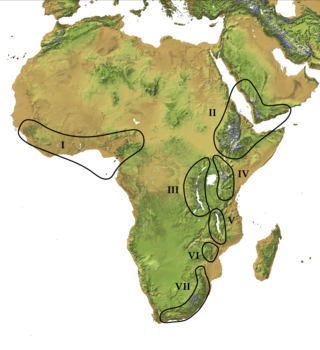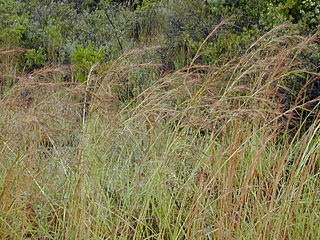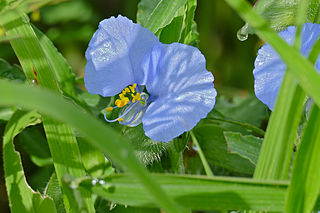
Disa is a genus of flowering plants in the family Orchidaceae. It comprises about 182 species. Most of the species are indigenous to tropical and southern Africa, with a few more in the Arabian Peninsula, Madagascar, and Réunion. Disa bracteata is naturalised in Western Australia, where the local name is "African weed-orchid."

Olea is a genus of flowering plants in the family Oleaceae. It includes 12 species native to warm temperate and tropical regions of the Middle East, southern Europe, Africa, southern Asia, and Australasia. They are evergreen trees and shrubs, with small, opposite, entire leaves. The fruit is a drupe. Leaves of Olea contain trichosclereids.

Euclea, from the Greek eukleia meaning "glory and fame", denotes a group of flowering plants in the Ebenaceae or ebony family. They were described as a genus by Linnaeus in 1774. The genus includes evergreen trees and shrubs, native to Africa, the Comoro Islands and Arabia. Several species are used for timber, producing a hard, dark heartwood timber similar to ebony.

Olea capensis, the black ironwood, is an African tree species in the olive family Oleaceae. It is widespread in sub-Saharan Africa: from the east in Somalia, Ethiopia and Sudan, south to the tip of South Africa, and west to Cameroon, Sierra Leone and the islands of the Gulf of Guinea, as well as Madagascar and the Comoros. It occurs in bush, littoral scrub and evergreen forest.

The Afromontane regions are subregions of the Afrotropical realm, one of the Earth's eight biogeographic realms, covering the plant and animal species found in the mountains of Africa and the southern Arabian Peninsula. The Afromontane regions of Africa are discontinuous, separated from each other by lower-lying areas, and are sometimes referred to as the Afromontane archipelago, as their distribution is analogous to a series of sky islands.

Gymnosphaera capensis, synonyms Alsophila capensis and Cyathea capensis, is a regionally widespread and highly variable species of tree fern. It is indigenous to Southern Africa and South America.

The fan-tailed widowbird, also known as the red-shouldered widowbird, is a species of bird in the family Ploceidae, which is native to grassy and swampy areas of the tropical and subtropical Afrotropics.

Angraecopsis is a genus of plants in the family Orchidaceae. It was first described by Fritz Kraenzlin in 1900 and given its name on account with the genus' similarity to Angraecum species. Angraecopsis are native to Africa, Madagascar, Réunion, Mauritius and the Comoros. The growth habit is rather small and the leaves emerge from a woody stem.

Hyparrhenia is a genus of grasses. Many species are known commonly as thatching grass.

Sacciolepis is a genus of plants in the grass family. Cupscale grass is a common name for plants in this genus.

Bolusiella is a genus of flowering plants from the orchid family, Orchidaceae. It consists of 4 currently recognized species that are endemic to sub-Saharan Africa and the Comoro Islands.
Agathisanthemum is a genus of flowering plants in the family Rubiaceae. It was described by Johann Friedrich Klotzsch in 1861. It is found in tropical and southern Africa, on the Comoros and in Madagascar.
Cyperus laxus is a sedge species in the Cyperaceae. It is native to tropical regions of the Western Hemisphere and also to Africa. The species is reportedly naturalized in Assam and the Andaman and Nicobar Islands.

Commelina eckloniana is an herbaceous plant in the dayflower family with a broad distribution in Central and East Africa.
Cremaspora is a genus of flowering plants in the family Rubiaceae. It is the only genus in the tribe Cremasporeae. It was described by George Bentham in 1849. The genus is widespread across much of sub-Saharan Africa from Senegal to Tanzania and south to Mozambique and Zimbabwe, in addition to Madagascar, Comoros, and Cape Verde. There are, however, only two currently recognized species.

The Ficus sansibarica, known as knobbly fig, is an African species of cauliflorous fig. It is named after Zanzibar, where Franz Stuhlmann discovered it in 1889. They often begin life as epiphytes, which assume a strangling habit as they develop. They regularly reach 10 m, but may grow up to 40 m tall as forest stranglers.

Scadoxus pole-evansii, commonly known as the Inyanga fireball, is a herbaceous plant endemic to mountains in east Zimbabwe. It was only discovered for science in 1960. Similar in many respects to the more widely grown Scadoxus multiflorus, it is cultivated as an ornamental plant.
Aningeria adolfi-friederici is a species of plant in the family Sapotaceae, a tall, tropical forest tree. It is found in Burundi, the Democratic Republic of the Congo, Ethiopia, Kenya, Malawi, Rwanda, Sudan, Tanzania, Uganda, Zambia and Zimbabwe. The specific name adolfi-friedericii was given in honour of Duke Adolf Friedrich of Mecklenburg, a German explorer in Africa. Its trade name muna is taken from Gĩkũyũ mũna.

Gardenia volkensii, commonly known as bushveldt gardenia or Transvaal gardenia, is a species of plant in the family Rubiaceae native to southern Africa.

Commelina africana, the common yellow commelina, is a widespread species of flowering plant in the family Commelinaceae. It is native to Sub‑Saharan Africa, Madagascar, Réunion, and the Arabian Peninsula, and has been introduced to India. It is occasionally consumed as a leaf vegetable, and occasionally fed to rabbits and pigs.















